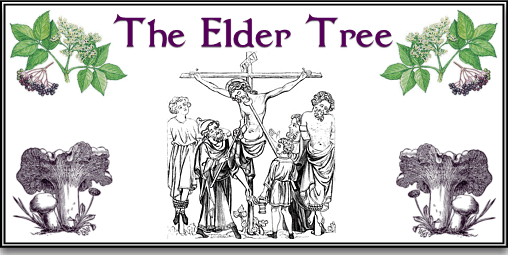
Take a look at any hedgerow and this year in particular (2006) they are loaded with berries and no more so than the elder berry. The roots of the elder tree descends deep into the depths of time. Since the Christian era the tree has been regarded as something of a bad omen, mainly because the cross on which Jesus was crucified was made from elder. It is also the tree that the infamous traitor, Judas hung himself from. Therefore on parts of the moor, especially in the Moretonhampstead area it was considered unlucky to bring any part of the tree into the house. Indeed a local saying was that, “if you burn elder , you skin a sheep”, which meant the death of your livestock. It is a well known fact that when elder wood burns it spits like a cobra and the reason for this is quite simple – it’s not the wood but the devil spitting down the chimney!
However, outside the house the elder tree was regarded as a protector against witches and all manner of evil, especially if the tree was self-sown. Some farms used to hang crosses of elder up in the parlours and shippens to protect the animals from witchcraft. In some parts a sprig of elder leaves would be placed in the hat to act as a fly repellent, what was that quote from Monty Python? Oh yes, “Your mother was a hamster and your father smelled of elderberries”. As ‘tackers’ we used to hollow out the young shoots to use as pea-shooters and whistles. In fact if its Latin name of Sambucus is anything to go by we were not the first to do so, the name is derived from the Greek word – sambuca which was an ancient musical instrument akin the the bagpipes.
![]()
Elder
Feigns death in winter, none lives better,
Chewed by cattle springs up stronger;
an odd Personal smell and unlovable skin;
Straight shoots like organ pipes in cigarette paper;
No nurseryman would sell you an Elder
‘not bush, not tree, not bad, not good’,
Judas was surely a fragile man
To hang himself from this ‘God’s stinking tree’.
In summer it juggles flower-plates in air,
Creamy as cumulus, and berries, each a weasel’s eye of light.
Pretends it’s unburnable (Who burns it sees the Devil),
cringes, hides a soul of cream plates,
purple fruits in a rattle of bones,
A good example.
P. J. Kavanagh.
![]()
But my childhood memories of the elder tree bring back images of hours spent picking the tiny berries and the purple stains left afterwards, hell and they say the indelible marker-pen is a modern invention! The actual picking wasn’t so bad it was the de-stalking afterwards that really got on my tripe, fiddly, squashy, runty, berries. That was the only benefit of a late harvest, you could slope off down the fields and stack bales, that way you only got red hands whose colour quickly faded with the blisters. But, when the elderberry jelly and cream came out or the sly nip from an unguarded wine glass was stolen it seemed to dim the memories of picking into insignificance, or maybe that was the strength of the elderberry wine? I can recall one hot summer’s day when a gang of us went exploring and came across a deserted barn. During our search we found two dusty old bottles up in the loft. Each had a faded label on which simply said, “Elderberry 1948”, and judging by how sick we were after drinking it I would imagine that was the proof!
I have already hinted at the staining qualities of the elder berries and so it should come as no surprise that the juice has been used for dyeing cloth for centuries. It was also used as a permanent ink-black hair dye which judging from the price of modern hair dyes could save a fortune. In fact having recently done a young archaeologists class about prehistoric art I can attest to the quality of paint made from elderberry juice. I also have a feeling that one or two parents have also been introduced to its fabric dyeing abilities, but best not mention that.
Medicinally the elder tree is a veritable natural medicine cabinet and has been so for eons. There is a record from the Chudleigh area for preventing the plague. It involved pounding a handful of elder leaves, sage and rue which was then strained with a quart of white wine. To this a spoonful of ginger or treacle was added as a sweetener and the jollup was then taken morning and night. Similarly, two handfuls of dried elder buds could be mixed with two handfuls of peppermint and then infused in a teapot with a couple of pints of boiling water for half an hour. The resulting concoction was then taken to cure fever, colds, influenza, and inflammation. An infusion of elder flowers is still sometimes used as a treatment for bronchitis or chesty coughs. The leaves are said to relieve the discomfort of nettle stings as well as ease leg sores when bandaged over the wound. There is also a tradition that if the leaves are chewed they can numb the agony of toothache, probably you forget about the pain whilst you are busy spitting out the masticated pulp and trying to get the bitter taste from your mouth. An hot water infusion of elder bark will cure constipation should that be your want, but a good toping session on the elderberry wine works and tastes better. So there you have it, although regarded in superstition as an evil tree it does provide a host of useful resources for ones palette and health.
 Legendary Dartmoor The many aspects past and present of Dartmoor
Legendary Dartmoor The many aspects past and present of Dartmoor
